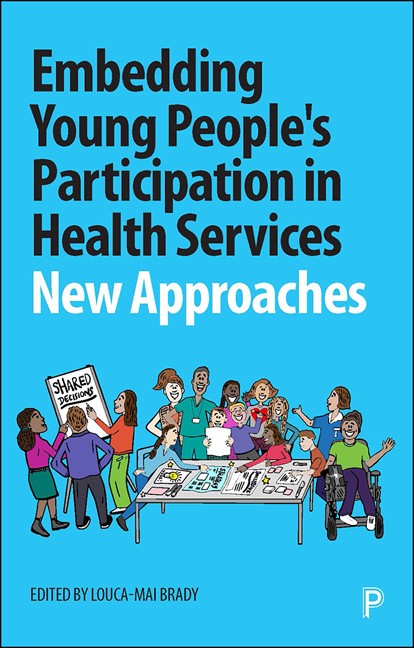Book contents
- Frontmatter
- Dedication
- Contents
- List of Boxes, Figures and Tables
- Summary
- Notes on Contributors
- Acknowledgements
- Foreword
- Introduction: Embedding Young People’s Participation in Healthcare
- PART I Young People’s Participation in Individual Decision-Making
- PART II Participation in National Projects and Programmes
- PART III Collaborative Research in NHS Services
- PART IV Young People-led Participation
- Index
Foreword
Published online by Cambridge University Press: 25 February 2021
- Frontmatter
- Dedication
- Contents
- List of Boxes, Figures and Tables
- Summary
- Notes on Contributors
- Acknowledgements
- Foreword
- Introduction: Embedding Young People’s Participation in Healthcare
- PART I Young People’s Participation in Individual Decision-Making
- PART II Participation in National Projects and Programmes
- PART III Collaborative Research in NHS Services
- PART IV Young People-led Participation
- Index
Summary
I was reflecting on the importance of children and young people's active participation in their healthcare, along with their broader contribution of participating in service development at a commissioning meeting recently. Around the table sat professionals, all with many letters after their names and years of experience in providing and commissioning of healthcare, yet not one of them was under 25. As is usual in these types of gatherings we got on to the subject of ‘so what do children and young people want?’ We had plenty of reports to refer to, from HealthWatch colleagues who regularly engage with children and young people about ‘what matters most to them’, to insights from local Trusts who have youth forums, along with representatives at the table from voluntary organisations who help make connections with relevant population groups, and insights from digital engagement on a variety of social media platforms. Yet it was a colleague who made me think when she referred to some national engagement work with children and young people: “Well, the engagement work has been done, we can use that and push on”, she commented. It made me reflect that of course we can use engagement work done by others to inform ongoing service improvement, but if we just do that we haven't really ‘got’ the real ‘magic’ of participation and the personal development and other benefits it brings for children and young people.
Healthcare professionals still view participation through the lens of providing beneficial insight to providers of services which will ideally lead to improved experience and outcomes for current and future service users. Yet the benefits of participation are much broader. The fact is participation and meaningful co-production not only benefit health services, there is the additional element that the children and young people who engage in the process flourish and thrive when they are active participants as partners in improvement journeys. The contribution of children and young people benefits not only their physical and mental wellbeing, but that of their peers and families as they convey vital health information that they have been involved in, in meaningful ways.
- Type
- Chapter
- Information
- Embedding Young People's Participation in Health ServicesNew Approaches, pp. xxv - xxviiiPublisher: Bristol University PressPrint publication year: 2020

